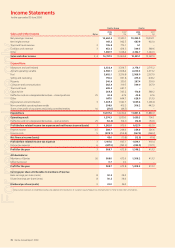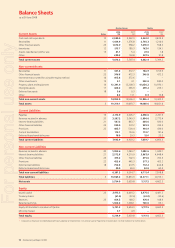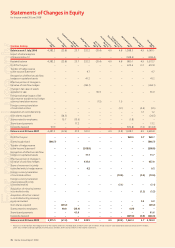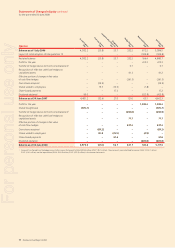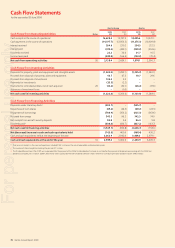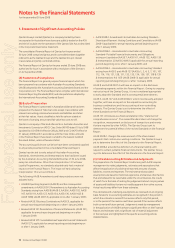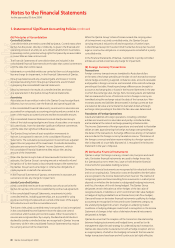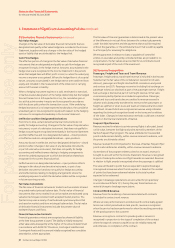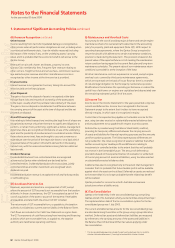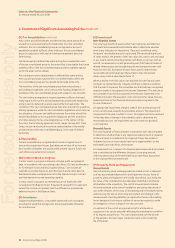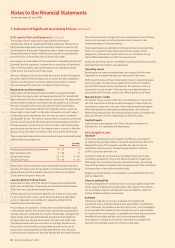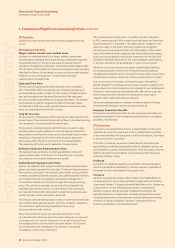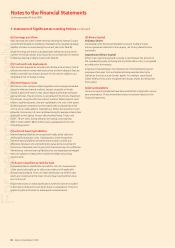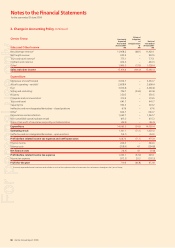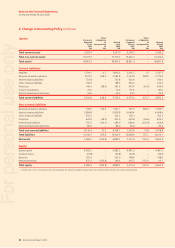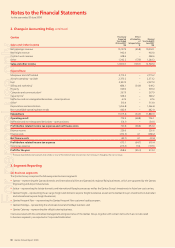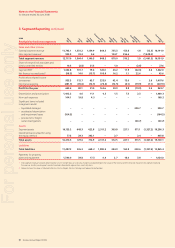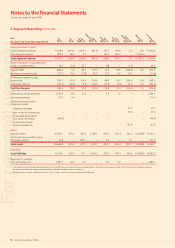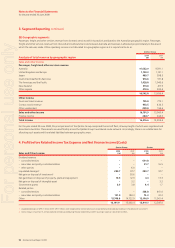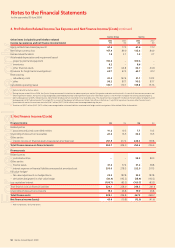Qantas 2008 Annual Report Download - page 86
Download and view the complete annual report
Please find page 86 of the 2008 Qantas annual report below. You can navigate through the pages in the report by either clicking on the pages listed below, or by using the keyword search tool below to find specific information within the annual report.
84 Qantas Annual Report 2008
(P) Property, Plant and Equipment continued
The standard cost of subsequent major airframe and engine
maintenance checks is capitalised and depreciated over the shorter of
the scheduled usage period to the next major inspection event or the
remaining life of the aircraft. Manpower costs in relation to employees
that are dedicated to major modifi cations to aircraft are capitalised as
part of the cost of the modifi cation to which they relate.
Borrowing costs associated with the acquisition of qualifying assets such
as aircraft and the acquisition, construction or production of signifi cant
items of other property, plant and equipment are capitalised as part
of the cost of the asset to which they relate.
When an obligation exists to dismantle and remove an item of property,
the present value of the estimated cost to restore the site is capitalised
into the cost of the asset to which it relates and a provision created.
The unwinding of the discount is treated as a fi nance charge.
Depreciation and Amortisation
Depreciation and amortisation are provided on a straight-line basis
on all items of property, plant and equipment except for freehold and
leasehold land which are not depreciated or amortised. The depreciation
and amortisation rates of owned assets are calculated so as to allocate
the cost or valuation of an asset, less any estimated residual value,
over the asset’s estimated useful life to the Qantas Group. Assets are
depreciated or amortised from the date of acquisition or, with respect
to internally constructed assets, from the time an asset is completed
and available for use. The costs of improvements to assets are amortised
over the remaining useful life of the asset or the estimated useful life of
the improvement, whichever is the shorter. Assets under fi nance lease
are amortised over the term of the relevant lease or, where it is likely the
Qantas Group will obtain ownership of the asset, the life of the asset.
The principal asset depreciation and amortisation periods and estimated
residual value percentages are:
Years
Residual
Value (%)
Buildings and leasehold improvements 10 – 50 0
Plant and equipment 3 – 40 0
Aircraft and engines 2.5 – 20 0 – 20
Aircraft spare parts 15 – 20 0 – 20
Depreciation and amortisation rates and residual values are reviewed
annually and reassessed having regard to commercial and technological
developments and the estimated useful life of assets to the Qantas
Group and the long-term fl eet plan.
Leased and Hire Purchase Assets
Leased assets under which the Qantas Group assumes substantially
all the risks and benefi ts of ownership are classifi ed as fi nance leases.
Other leases are classifi ed as operating leases.
Linked transactions involving the legal form of a lease are accounted
for as one transaction when a series of transactions are negotiated
as one or take place concurrently or in sequence and cannot be
understood economically alone.
Finance leases are capitalised. A lease asset and a lease liability equal
to the present value of the minimum lease payments and guaranteed
residual value are recorded at the inception of the lease. Any gains and
losses arising under sale and leaseback arrangements are deferred
and amortised over the lease term where the sale is not at fair value.
Capitalised leased assets are amortised on a straight-line basis over
the period in which benefi ts are expected to arise from the use of
those assets. Lease payments are allocated between the reduction
in the principal component of the lease liability and the interest element.
The interest element is charged to the Income Statement over the lease
term so as to produce a constant periodic rate of interest on the
remaining balance of the lease liability.
Fully prepaid leases are classifi ed in the Balance Sheet as hire purchase
assets, to recognise that the fi nancing structures impose certain
obligations, commitments and/or restrictions on the Qantas Group,
which differentiate these aircraft from owned assets.
Leases are deemed to be non-cancellable if signifi cant fi nancial penalties
associated with termination are anticipated.
Operating Leases
Rental payments under operating leases are charged to the Income
Statement on a straight-line basis over the period of the lease.
With respect to any premises rented under long-term operating leases,
which are subject to sub-tenancy agreements, provision is made for
any shortfall between primary payments to the head lessor less any
recoveries from sub-tenants. These provisions are determined on a
discounted cash fl ow basis, using a rate refl ecting the cost of funds.
Manufacturers’ Credits
The Qantas Group receives credits from manufacturers in connection
with the acquisition of certain aircraft and engines. These credits are
recorded as a reduction to the cost of the related aircraft and engines.
Where the aircraft are held under operating leases, the credits are
deferred and reduced from the operating lease rentals on a straight-line
basis over the period of the related lease as deferred credits.
Capital Projects
Capital projects are stated at cost. When the asset is ready for its
intended use, it is capitalised and depreciated.
(Q) Intangible Assets
Goodwill
All business combinations since transition to IFRS are accounted for
by applying the purchase method. Goodwill represents the difference
between the cost of the acquisition and the fair value of the net
identifi able assets acquired. Goodwill acquired before transition
to IFRS is carried at deemed cost.
Goodwill is stated at cost less any accumulated impairment losses.
Goodwill is allocated to CGUs and is tested annually for impairment.
With respect to associates and jointly controlled entities, the carrying
amount of goodwill is included in the carrying amount of the investment
in the associate or the jointly controlled entity.
Negative goodwill arising on an acquisition is recognised directly in the
Income Statement.
Airport Landing Slots
Airport landing slots are stated at cost less any accumulated impairment
losses. Airport landing slots are allocated to the relevant CGU and are
not amortised as they are considered to have an indefi nite useful life
and are tested annually for impairment.
Software
Software is stated at cost less accumulated amortisation and
impairment losses. Software development expenditure, including the
cost of materials, direct labour and other direct costs, is only recognised
as an asset when the Qantas Group controls future economic benefi ts
as a result of the costs incurred, it is probable that those future economic
benefi ts will eventuate and the costs can be measured reliably.
Amortisation is charged to the Income Statement on a straight-line
basis over the estimated useful life of three to fi ve years.
Notes to the Financial Statements
for the year ended 30 June 2008
1. Statement of Significant Accounting Policies continued
For personal use only


